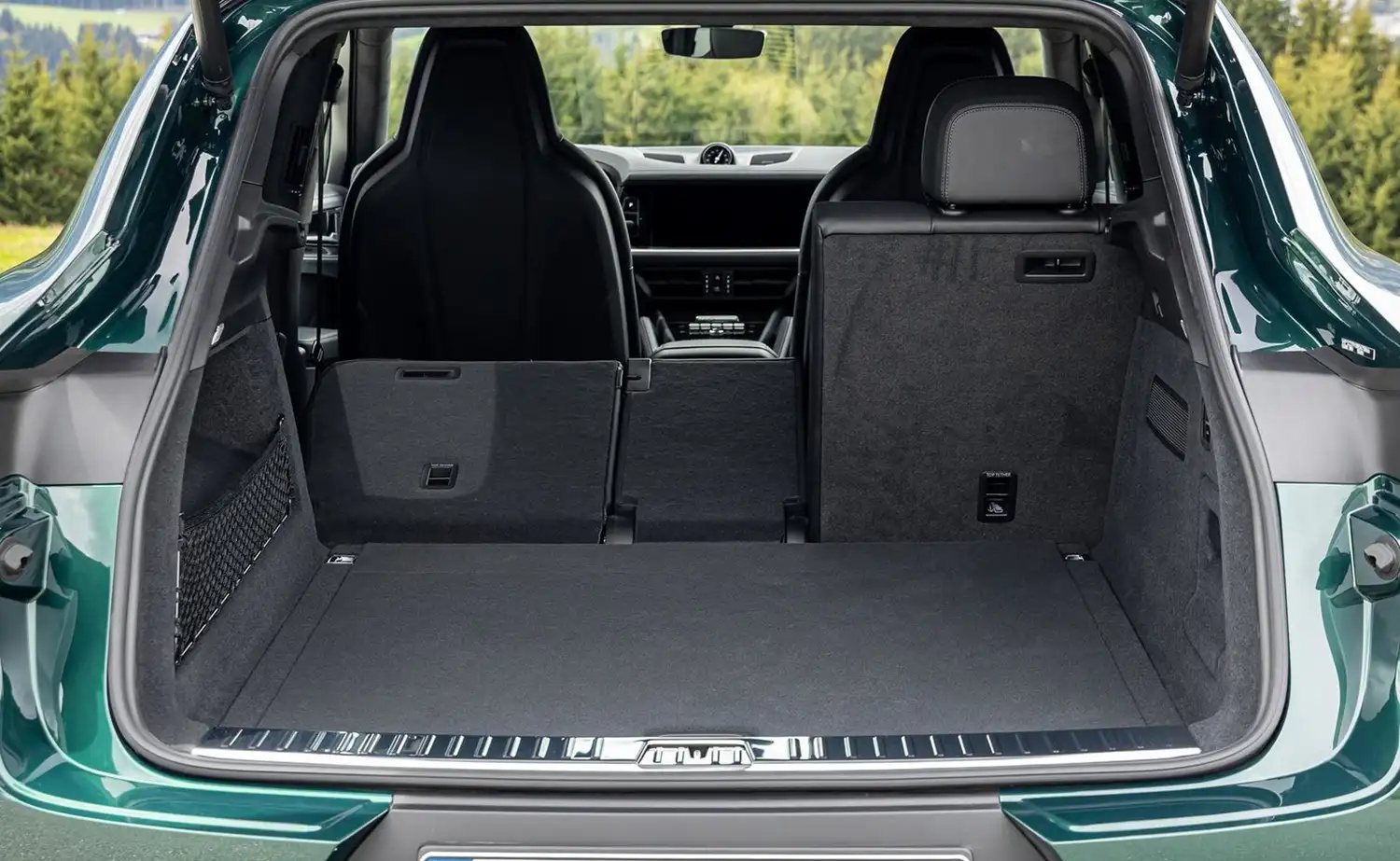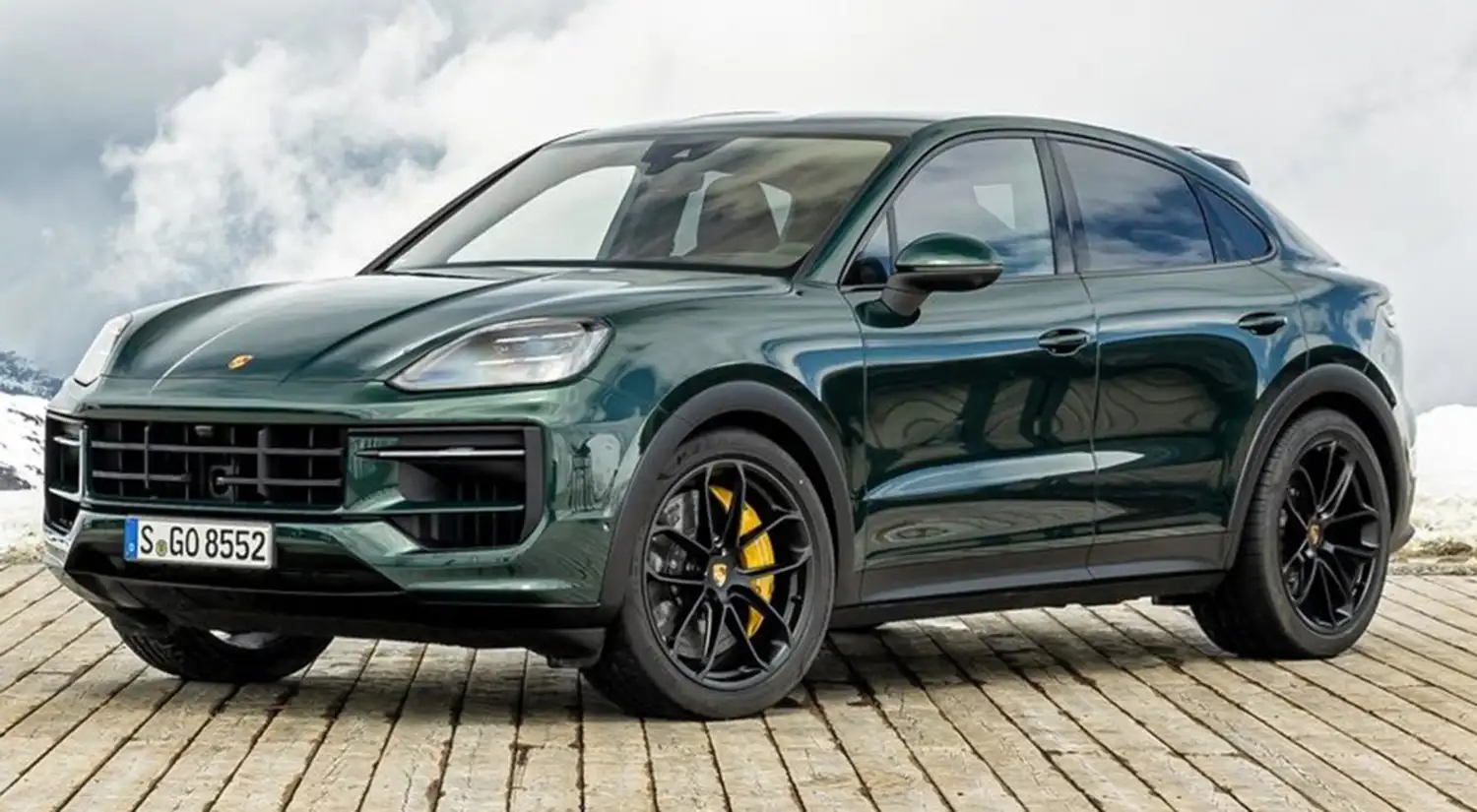
Porsche has thoroughly refined its successful luxury SUV. The new Cayenne comes with a highly digitalised display and control concept, new chassis technology and innovative high-tech features. “It’s one of the most extensive product upgrades in the history of Porsche,” says Michael Schätzle, Vice President Product Line Cayenne. HD-Matrix LED Headlights provide road illumination tailored to every driving situation, an air quality system filters pollutants from the air in the interior and, for the first time in the Cayenne, front passengers have their own infotainment display – for streaming videos during journeys, for example. With its extensively upgraded design and more powerful engine range, the Cayenne underlines its claim to be the sportiest car in its segment.
Porsche has integrated a completely revised display and control concept into the new Cayenne. The new Porsche Driver Experience, first introduced in the Porsche Taycan, focuses on the driver’s axis and optimises operation. Functions that the driver uses frequently are located directly on or immediately next to the steering wheel. For example, the lever located on the left behind the steering wheel now has additional functions for operating the driver assistance systems. The automatic gear selector in the new Cayenne is also now to the right of the steering wheel on the dashboard in left-hand drive vehicles. This makes room on the new centre console for storage compartments and a large air conditioning controller in an elegant black panel design. Large, easily accessible controls combined with mechanical air conditioning switches and a haptic volume controller ensure optimum usability and a refined look.

For the first time, the redesigned cockpit of the Cayenne includes a fully digital 12.6-inch instrument cluster with a curved design and variable display options. An optimised head-up display is available as an option. The standard 12.3-inch central Porsche Communication Management (PCM) display integrates seamlessly into the new dashboard and provides access to all the relevant vehicle functions. Native apps such as Spotify® and Apple Music® are provided to optimise connectivity in the new Cayenne. A 10.9-inch display is now available for the first time for the passenger side. This enriches the front passenger’s experience by displaying performance data, providing separate access to the infotainment system controls and, depending on the market, the option of streaming videos while on the road. A special film coating ensures that the driver cannot see this display.
The new Cayenne now has a particularly expressive and athletic appearance. A new front end combined with more strongly arched wings, a new bonnet and technical-looking headlights emphasise the car’s width. Three-dimensionally designed tail lights, uncluttered surfaces and a new rear bumper with integrated number plate holder characterise the rear end of the new Cayenne. An expanded colour palette with three new colours, lightweight sports packages saving up to 33 kilograms for the Cayenne Coupé, and an extensive range of 20-, 21-, and 22-inch wheels make it possible to aesthetically and dynamically configure the new Cayenne to each customer’s individual taste.
Matrix LED Headlights are now standard equipment in the new Cayenne. HD-Matrix LED Headlights are a new optional feature. With two high-definition modules and more than 32,000 pixels per headlamp, their innovative technology blocks out the light of the high beam for other road users, with pixel accuracy, so as not to dazzle them. The brightness of the modules can be regulated in more than 1,000 steps depending on the driving situation. Customised light modes increase safety and comfort in different driving situations.
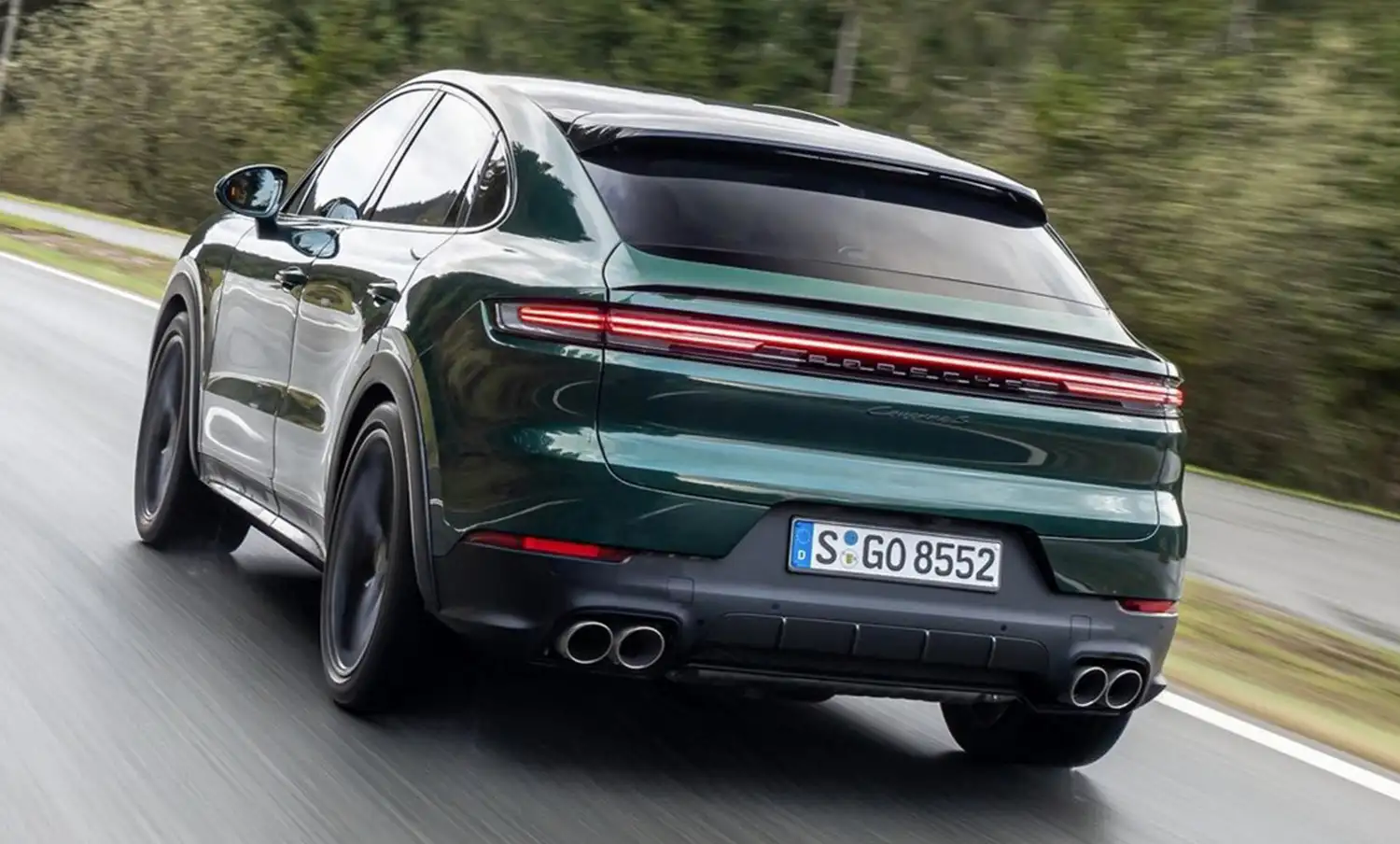
Porsche has also introduced an air quality system in the new Cayenne. As standard, the vehicle uses predictive navigation data to detect approaching tunnel entrances and automatically activates air recirculation. Optionally, a sensor can detect the level of fine dust particles in the air and pass it through a fine dust filter multiple times if necessary. Furthermore, an ioniser removes many germs and pollutants from the air, which is particularly beneficial for allergy sufferers.
In addition, customers can use a comprehensive range of new and optimised assistance systems. These include Evasion Assist, cornering assist and the improved Porsche InnoDrive as part of the adaptive cruise control. This means that the new Cayenne is even better at helping its driver in dangerous situations as well as in traffic jams on motorways and main roads.
Porsche now equips the Cayenne as standard with steel-spring suspension including Porsche Active Suspension Management (PASM). New shock absorbers with two-valve technology enable optimised performance in all driving situations. In particular, comfort at slow speeds, handling during dynamic cornering, and pitch and roll support have been noticeably improved. The driving experience can be additionally enhanced with the new adaptive air suspension with two-chamber, two-valve technology. This improves the driving experience, stabilises the vehicle and simplifies handling on- and off-road compared to both the standard suspension and the previous model. At the same time, the adaptive air suspension improves driving precision and performance, and reduces body movements in dynamic driving situations. The suspension also offers an even sharper differentiation between Normal, Sport and Sport Plus driving modes.
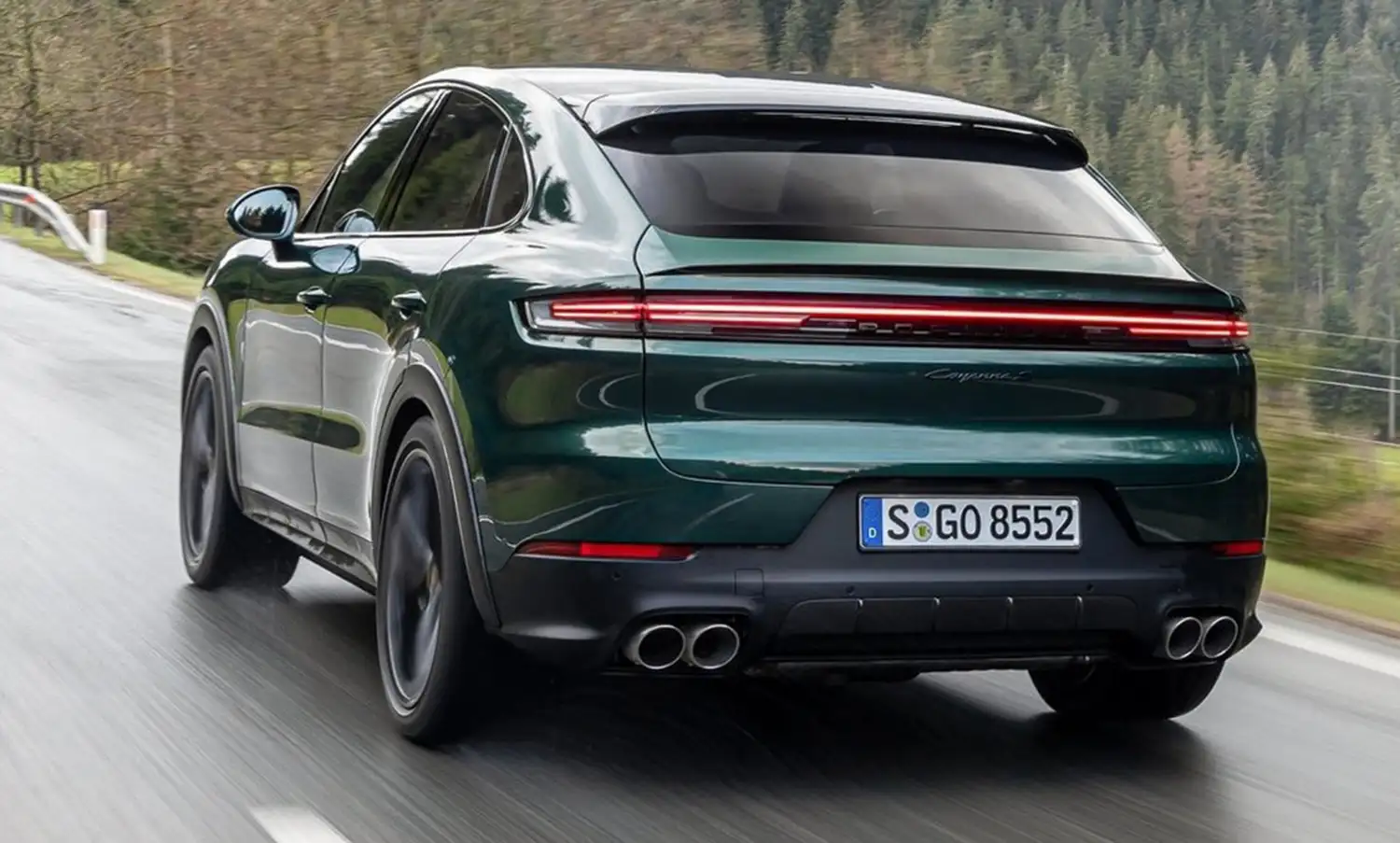
In Europe, the new Cayenne is making its debut with three different engine versions. An extensively revised version of the 4.0-litre V8 biturbo engine developed by Porsche replaces the previous V6 engine in the new Cayenne S. With a maximum power output of 349 kW (474 PS) and torque of 600 Nm – 25 kW (34 PS) and 50 Nm more than its predecessor – it accelerates both the SUV and the SUV Coupé to 100 km/h in 4.7 seconds. Top speed is 273 km/h. The entry into the world of the Cayenne comes with an optimised 3.0-litre V6 turbo engine. It now generates 260 kW (353 PS) and 500 Nm, which is 10 kW (13 PS) and 50 Nm more than before.
The six-cylinder engine also forms the basis for the powertrain of the Cayenne E-Hybrid. In combination with a new electric motor with output increased by 30 kW to 130 kW (176 PS), the combined output increases to 346 kW (470 PS). Equipped with a high-voltage battery with a capacity increase from 17.9 kWh to 25.9 kWh, a purely electric range of up to 90 kilometres (EAER City) is now possible, depending on the equipment level. A new 11 kW on-board charger now shortens the charging time at an appropriate power source to less than two and a half hours despite the increased battery capacity. On the road, the optimised E-Hybrid driving modes increase the efficiency of the vehicle.
New Porsche Driver Experience makes its debut in the Cayenne
Porsche is introducing a groundbreaking display and control concept in the new Cayenne. The Porsche Driver Experience stands for a fully digital display, versatile individualisation and intuitive operation. At the heart of this is the focus on the driver’s axis. The most important controls are grouped around the steering wheel. This creates a new, even more intensive driving experience.
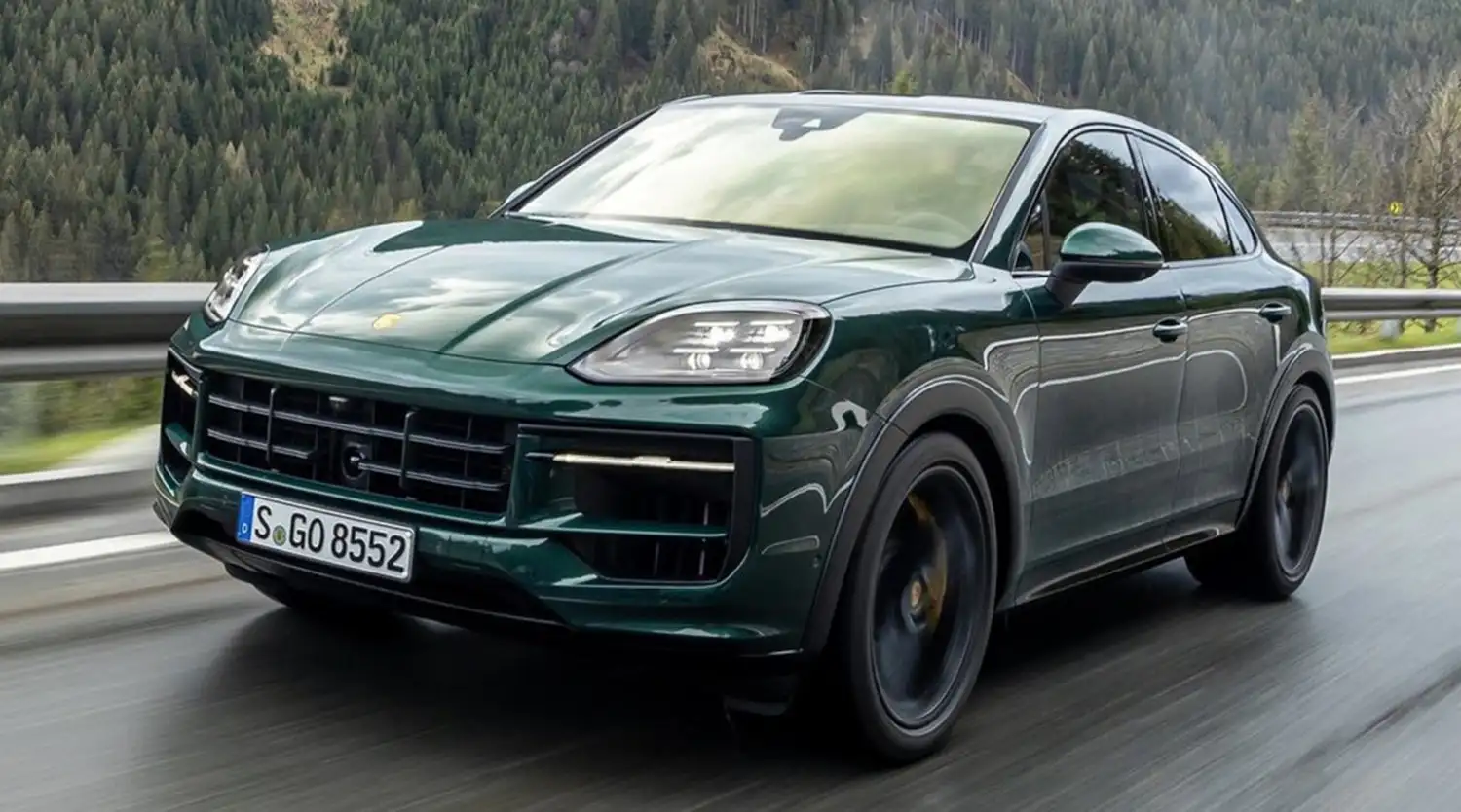
The sophisticated cockpit design takes elements of the Taycan electric sports car and transfers them for the first time to a Porsche with a combustion engine. It includes a digital instrument cluster with a curved and free-standing design, with variable display options, a redesigned centre console and a latest-generation steering wheel with a standard mode switch. The automatic gear selector is now located directly to the right of the steering wheel. This makes room on the centre console for a large air conditioning controller with a sophisticated black panel design. Passengers experience a new level of interaction with the vehicle and the driver via the optional passenger display.
A circumferential strip frames the entire dashboard, holistically tying the various design elements together and encompassing the redesigned door interiors as well. New trim strips and decorative surfaces, as well as the increase in colour and material options, provide visual highlights. Optimised connectivity functions and an optimised wireless charging function round off the new interior concept. Also completely new in the Porsche Cayenne is an in-car video function. Streaming content can be shown on the passenger display even during the drive, with technical safeguards ensuring that this does not distract the driver.
Driver-focused and interactive: the new cockpit in the Cayenne
Drivers and passengers experience a completely new cockpit in the new Porsche Cayenne. It combines an even stronger driver focus with new interactive elements that intensify the driving experience in a new way for the passenger as well. The instrument cluster is now a fully digital, free-standing, 12.6-inch curved display that does not require a hood cover, thereby giving it a modern, slimline appearance. In the characteristic Porsche style, this is the highest point on the dashboard. Depending on the equipment level, the driver can choose from up to seven views on the instrument cluster. The rev counter, map navigation, Night Vision Assist or 3D driver assistance system can all be selected to be in the foreground. A minimalistic view and a classic version are also available, the latter one transporting the typical Porsche five-gauge instrument cluster design into the digital age.
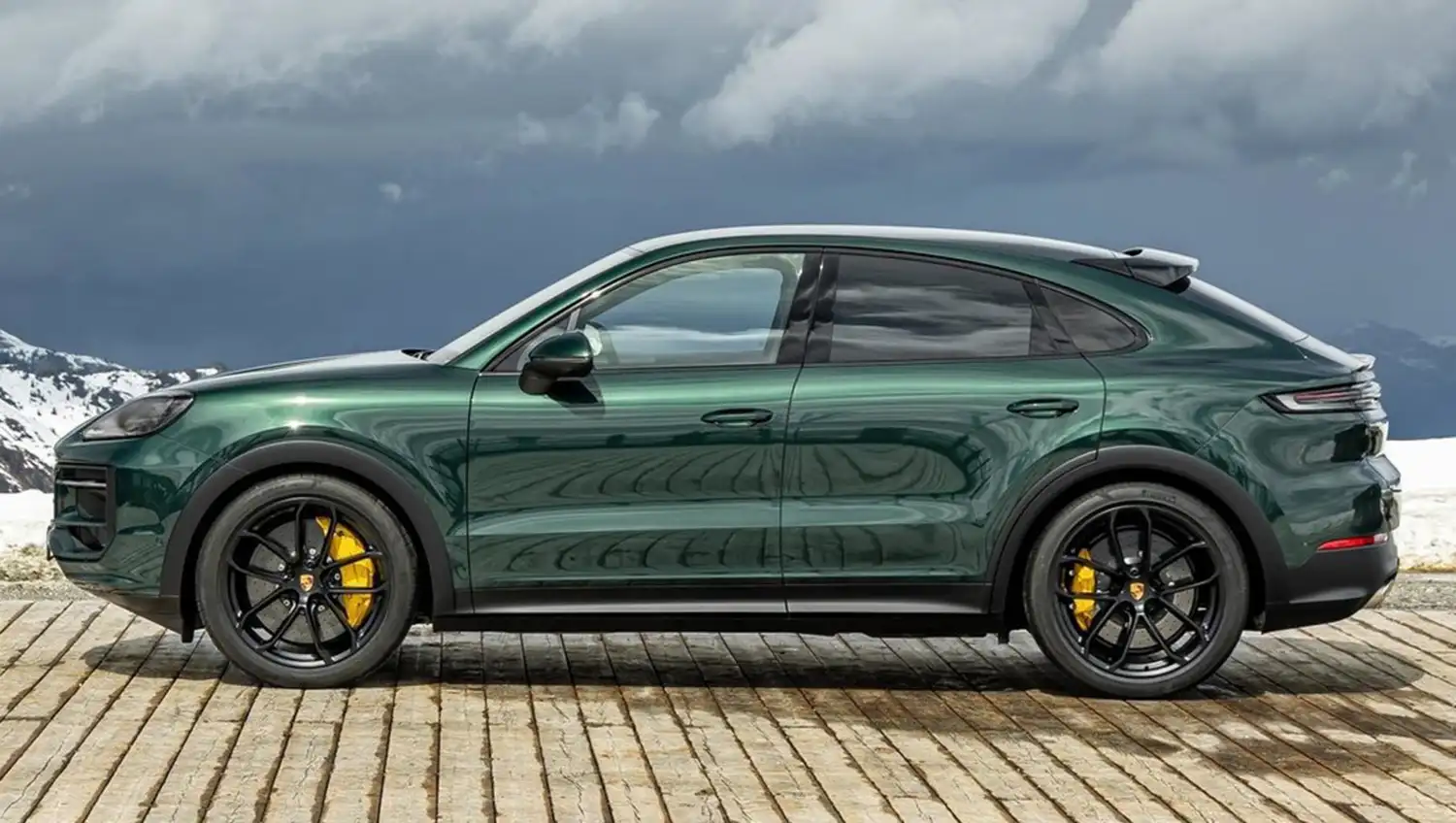
A key feature of the Porsche Driver Experience is the right balance between digital and analogue elements. All the controls that are important to the driving experience are also grouped directly around the steering wheel. In classic Porsche fashion, the new engine start button – making its first appearance in this form in a Porsche vehicle with an internal combustion engine – is to the left of the steering wheel.
The gear selector is now significantly smaller than before and situated to the right of the steering wheel between the instrument cluster and the central display. This makes room on the centre console for a new, large air conditioning control panel with analogue controls and more storage space. Porsche has also put the completely redesigned control lever for the driver assistance systems directly on the steering wheel column, making it immediately accessible to the driver in the new Cayenne.
The new multifunction sports steering wheel originates from the 911 and has been completely revamped compared to its predecessor. Its design is elegant, modern and sporty at the same time. The mode switch for selecting Normal, Offroad, Sport and Sport Plus driving modes directly on the steering wheel is now standard. The new toggle button for selecting functions and designs in the instrument cluster is also located directly on the steering wheel, just like the configuration of the optional head-up display. This enables drivers to adapt the head-up display to their size and position and to change views without taking their eyes off the road.
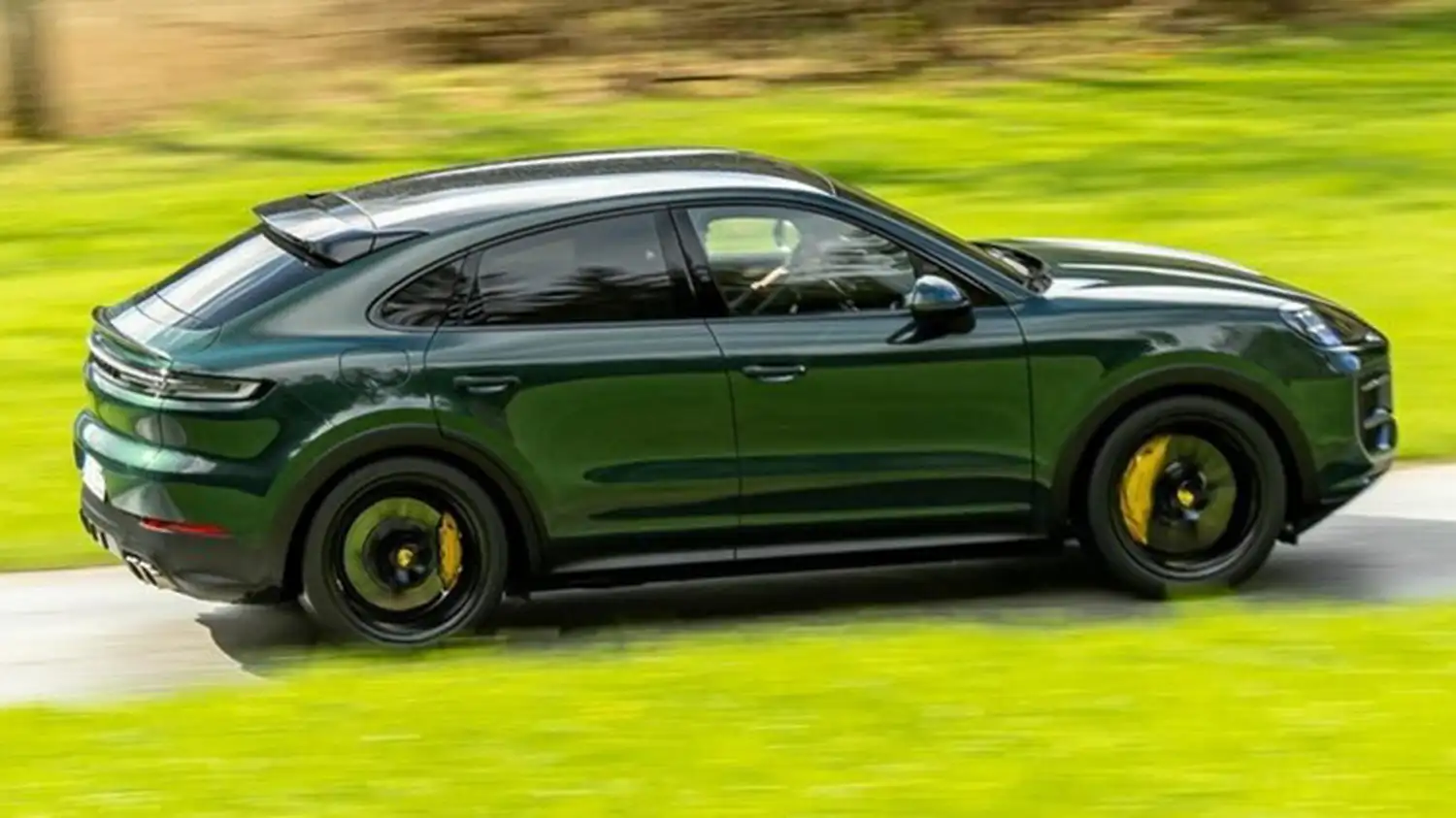
With its glass surface in a black panel design, the new air conditioning control panel on the rising centre console creates a particularly high-quality look. Air conditioning settings can be made quickly and intuitively on the clearly laid out control surface. The combination of touch recognition and tactile feedback with mechanical air conditioning switches as well as a physical volume controller ensures functionality that is both haptically and aesthetically pleasing.
The high-resolution 12.3-inch central display is the control centre of Porsche Communication Management (PCM). As before, the driver can use it to operate numerous driving and comfort functions, as well as the standard online navigation and multimedia functions. A completely new feature in the Porsche Cayenne is the optional integrated 10.9-inch passenger display. This additional touchscreen offers the passenger entirely new ways of interacting with the driver and the vehicle. Through the additional touchscreen, the front passenger can take the strain off the driver, for example by operating the navigation or selecting a media service. A special film ensures that the display cannot be seen from the driver’s seat. This means videos can be streamed on the passenger display without distracting the driver. The passenger can also have current information about the performance of the vehicle displayed – such as speed, driving mode and G-force. This enables the occupants in the new Cayenne to enjoy the Porsche driving experience more intensively together.
A luxurious, sporty feel
The Porsche Cayenne is the sportiest car in its segment – and its interior reflects this. A sporty ambience is combined with high functionality, luxurious comfort and typical Cayenne design features. Porsche presents the new control concept in the new Cayenne in a clean design that accentuates the width. The increased horizontal emphasis of the dashboard makes the interior look even wider. Designers achieve this with a circumferential strip that continues upwards on the sides. The elegantly designed air vents are vertically aligned in typical Cayenne fashion. For the first time, Porsche has designed all the air outlets in the cockpit without louvres.
Large-area decorative features and accent trims in the door panels pick up on the horizontal lines of the interior of the new Cayenne. Through the structural separation of the centre console and dashboard, designers have created a floating look in the cockpit. The Cayenne’s familiar centre console grab handles remain a defining feature of the SUV interior.

New air quality system for an optimal interior climate
The Porsche Cayenne has a new system which sets standards in terms of air quality in the vehicle by reliably protecting the passengers from particles and harmful substances in the outside air. The cabin air filter and the GPS recirculation function come fitted as standard. The new Cayenne uses predictive navigation data to automatically activate air recirculation when the car is about to enter a tunnel. This stops odours and exhaust fumes that might accumulate in the tunnel from getting into the passenger compartment. When route guidance is activated, the system acts predictively and takes tunnels along the route into account well ahead of time. An optional fine dust sensor also improves the air in the new Cayenne. It continuously measures the fine particle level (PM 2.5) in the vehicle interior as well as in the outside air and activates recirculation if the air quality around the vehicle declines. The air quality system then cleans the interior air by passing it through the fine dust filter several times. An ioniser is also optionally available to remove germs and pollutants from the air. This is particularly beneficial for allergy sufferers.
There are five new leather options in the new Cayenne. This includes the colour combinations Black/Crayon, Black/Night Green and Black/Bramble as well as the Club leather option in Basalt Black and the combination Basalt Black/Barrique Red. New decor and accent designs have also been added to the familiar customisation options for the interior. As before, the Porsche Cayenne can be equipped with an optional panoramic roof system that creates an even more spacious, bright feeling. The accompanying roller blind is always black. In the Cayenne Coupé, a fixed panoramic roof in glass comes standard. Other available options include a heated windscreen and thermally and acoustically insulated glass.
As standard features, Porsche equips the Cayenne with eight-way adjustable leather comfort seats and the Cayenne Coupé with eight-way adjustable sports seats. Both variants offer additional configuration options in a variety of different leather packages. The optional 18-way adjustable adaptive sports seats offer particularly sporty drivers optimal lateral support during dynamic driving thanks to raised seat bolsters. Other options include a massage function and front and rear seat ventilation and heating in addition to the standard heated front seats.
Comprehensively upgraded connectivity
Porsche has further improved connectivity in the new Cayenne. The Cayenne offers a cooled smartphone storage area with wireless charging as standard. The cooling allows an optimised charging power of up to 15 watts.
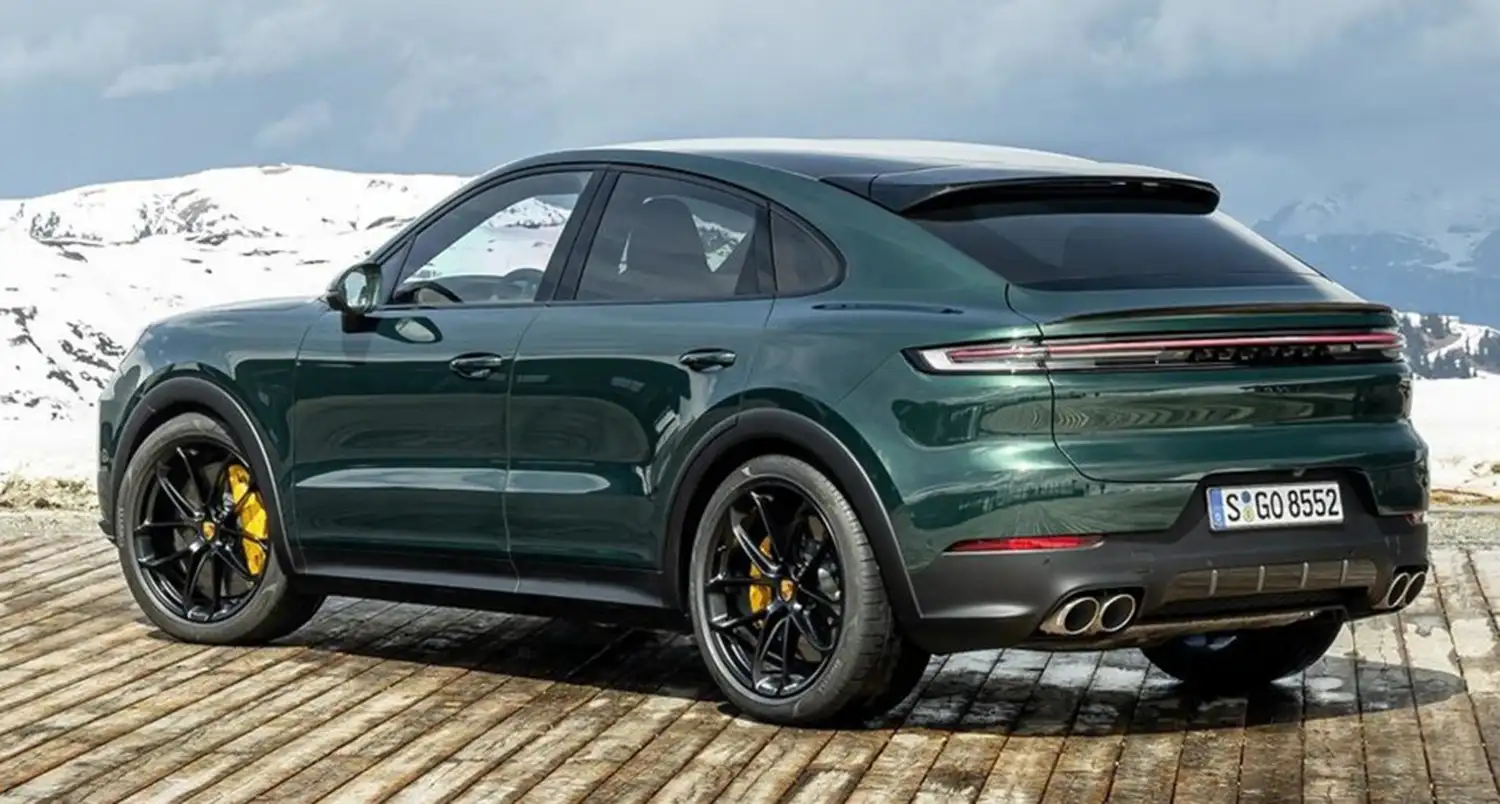
Also now optimised are two USB-C ports with a fast-charging function in the front storage compartment and another two USB-C fast-charging connections in the rear area of the centre console. To pair a smartphone with the vehicle, all you have to do is scan the QR code displayed in the PCM with the phone. Numerous connectivity functions are then available, including Apple CarPlay® and Android Auto® as well as integrated apps such as Spotify® and Apple Music®.
A new function in the Cayenne is In-Car Video. Videos can be watched directly in the PCM via streaming provider Screenhits TV® – both in the central display when the vehicle is stationary and in the passenger display while driving. A special film on the passenger display prevents the driver being distracted while the vehicle is moving.
A high-quality audio system contributes to the media experience in every Porsche Cayenne. As standard, Porsche equips the new Cayenne with the Sound Package Plus with 10 speakers. Alternatively, two other audio systems are available: a BOSE® Surround Sound System with 710 watts, 14 speakers and an additional subwoofer, and a Burmester® 3D High-End Surround Sound System with 21 speakers and a total output of 1,455 watts.
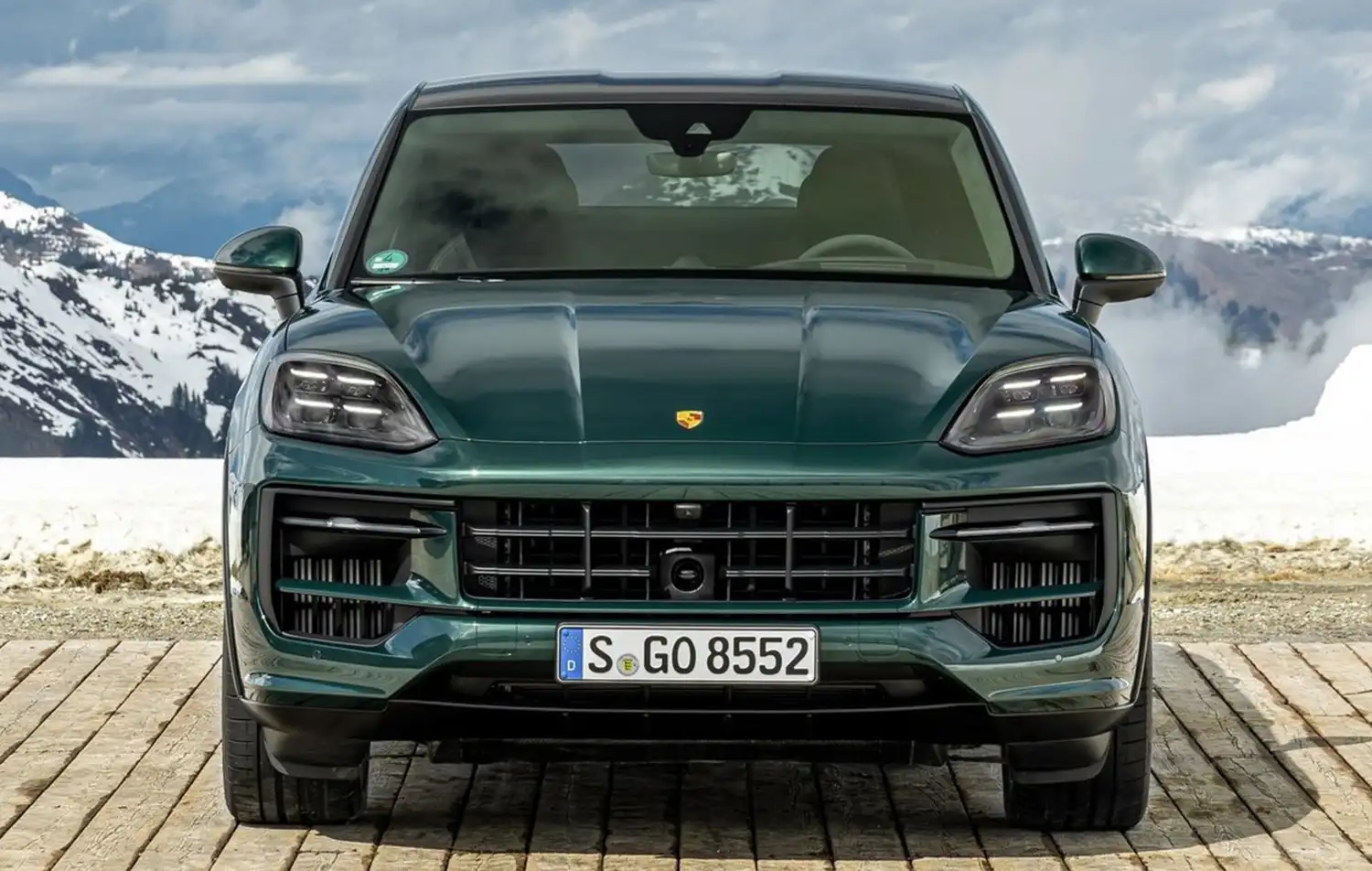
Sharpened form with accentuated width
The new Porsche Cayenne has a fundamentally overhauled appearance. The changes to the exterior go well beyond the usual extent of product upgrades. In addition to the front end, the rear apron and the headlights, the bonnet, wings and tailgate have also been redesigned. The result is a strikingly athletic and expressive attitude. This is created by the visual emphasis on the width of the vehicle, the more pronounced wings, the clear lines, the even more prominent air intakes as well as the redesigned headlights and lights.
The designers have put particular emphasis on the wings, which are now more arched. Between the wings, the redesigned bonnet has a flatter profile. The Cayenne’s headlights echo the lines of the wings and have a more horizontal and steeper stance in the vehicle front than in the previous Cayenne. Their insides provide a ened technical accent on the front end of the new Cayenne. Matrix LED Headlights are fitted as standard. Also available are the optional HD-Matrix LED Headlights, which enable Porsche’s characteristic four-point signature to be visible even at night and which significantly enhance both safety and comfort thanks to their innovative technology.
The larger air intakes at the front also contribute to the striking appearance of the new Cayenne. Two horizontal black bars with painted inlays in the front end lend additional emphasis to the vehicle width. With great attention to detail, the front light has been integrated into the upper vane.
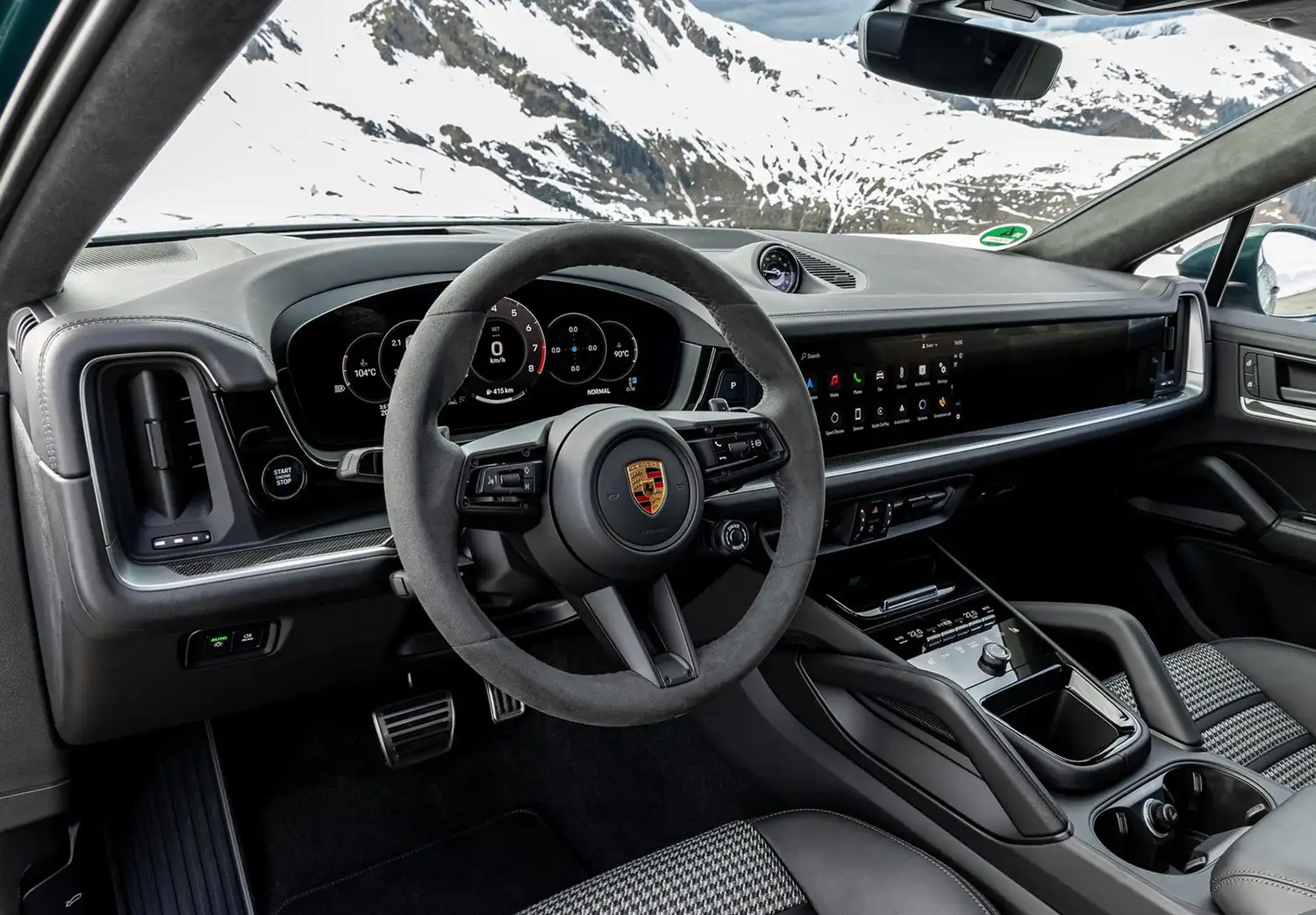
The new Cayenne also features a fundamentally overhauled design at the rear. As in the Coupé, the number plate holder is now located in the rear bumper in the regular Cayenne SUV, and the grip bar on the tailgate is also now gone. The complete LED light strip including the tail lights and indicators are made of a three-dimensionally sculptured glass, span the entire rear area like an arc and create an unmistakable light signature at night. The PORSCHE logo now also features a three-dimensional, free-standing design.
As before, the full SUV and the Coupé share an identical design at the front of the vehicle. With a flatter windscreen and a sharper A-pillar angle, the Coupé looks even more athletic and performance-focused with the design changes at the front, the new accents at the rear and the wider rear end.
The new Cayenne comes with 20-inch light-alloy wheels as standard. Porsche has also moved to a high wheel-diameter class of 790 millimetres. A total of 12 wheel designs in diameters of 20, 21 and 22 inches are available for the new Cayenne. This includes eight new light-alloy rims. For the first time, Porsche is also offering aerodynamically optimised wheel designs for the Cayenne, which reduce drag.
A total of 12 body colours are available for the new Porsche Cayenne, including the three new colours Algarve Blue Metallic, Montego Blue Metallic and Arctic Grey. In addition, the Paint to Sample option offers numerous additional colours to choose from – including particularly popular shades from Porsche history.
World premiere: the HD-Matrix LED Headlights
With the model change, the Cayenne now features new LED headlights with matrix beam technology as standard. They use speed, camera and navigation data to ensure ideal illumination. Their high beam area is divided into 11 segments that can be illuminated or dimmed according to the situation (known as a matrix beam). In this way, they enable optimal visibility with the high beam activated without dazzling vehicles ahead or oncoming traffic.
As an option, Porsche is also offering the high-resolution HD-Matrix LED lights for the first time in the new Cayenne. These innovative headlights create a bright, homogeneous and precise light area that adapts dynamically and at lightning speed to the respective driving situation. The new adaptation is calculated every 16 milliseconds. This technology also enables adaptive functions such as lane brightening, construction-site and bottleneck light or a dedicated motorway high-beam. The innovative headlights also stand out for their energy efficiency.
At the heart of the technology is a chip half the size of a thumbnail (12.8 by 3.2 mm), which holds 16,384 individual micro-LED pixels. Porsche installs two of these chips per headlight in the new Cayenne with HD-Matrix LED technology – four per vehicle. A control module, comparable in its function to a powerful PC graphics card, can activate, deactivate or dim each of the diodes in 1,024 steps. This makes it possible to produce an almost unlimited variety of light patterns. To optimally adapt the light pattern to the demands of a sports car, Porsche combines the chips with special lenses to create HD modules. One module per headlight has a wide-angle lens that allows for wide light dispersion. The ‘Illumination’ HD module covers an angle of 40 degrees of width by 10 degrees of . The respective ‘Performance’ module, equipped with a telephoto lens, focuses its light on a range of 20 degrees of width by five degrees of . The light from both modules overlaps and guarantees wide illumination with high intensity in the centre. Since only the required diodes are active at any given time, the HD-Matrix LED Headlights are exceptionally efficient.
The ‘Illumination’ and ‘Performance’ modules are adjacent to each other in the lower section of the headlights. Two bi-functional modules are positioned above them. They are responsible for courtesy lighting and the additional high beam. If the system does not detect any vehicles driving ahead or any oncoming traffic when the automatic high beam is activated, it switches on the additional high beam. This mode increases the amount of light from 1,400 to 2,500 lumens. This makes the new Cayenne capable of illuminating the road over a distance of up to 600 metres. As soon as the system detects a vehicle ahead or any oncoming traffic, it deactivates the additional high beam and returns to HD-Matrix mode. The four modules represent the characteristic Porsche light signature. It is active in all available light modes in the new HD-Matrix LED Headlights, including dipped and high beam modes.
With its pinpoint control of the light, the high-resolution headlight technology enables additional functions. If individual pixels are deactivated to avoid dazzling another vehicle, the additional available energy flows into the surrounding pixels and intensifies their brightness. This guarantees optimal visibility at all times. On motorways, the system controller adjusts the light distribution to the course of the road, accurate to the pixel, without dazzling the oncoming lanes of traffic. In construction areas and bottlenecks, a carpet of light in front of the new Cayenne marks the width of the vehicle, including its exterior mirrors, giving the driver additional confidence that they can position their vehicle accurately. What’s more, lane brightening helps the driver detect dangerous objects at an early stage. In this way, The HD-Matrix LED Headlights actively contribute to occupant safety.
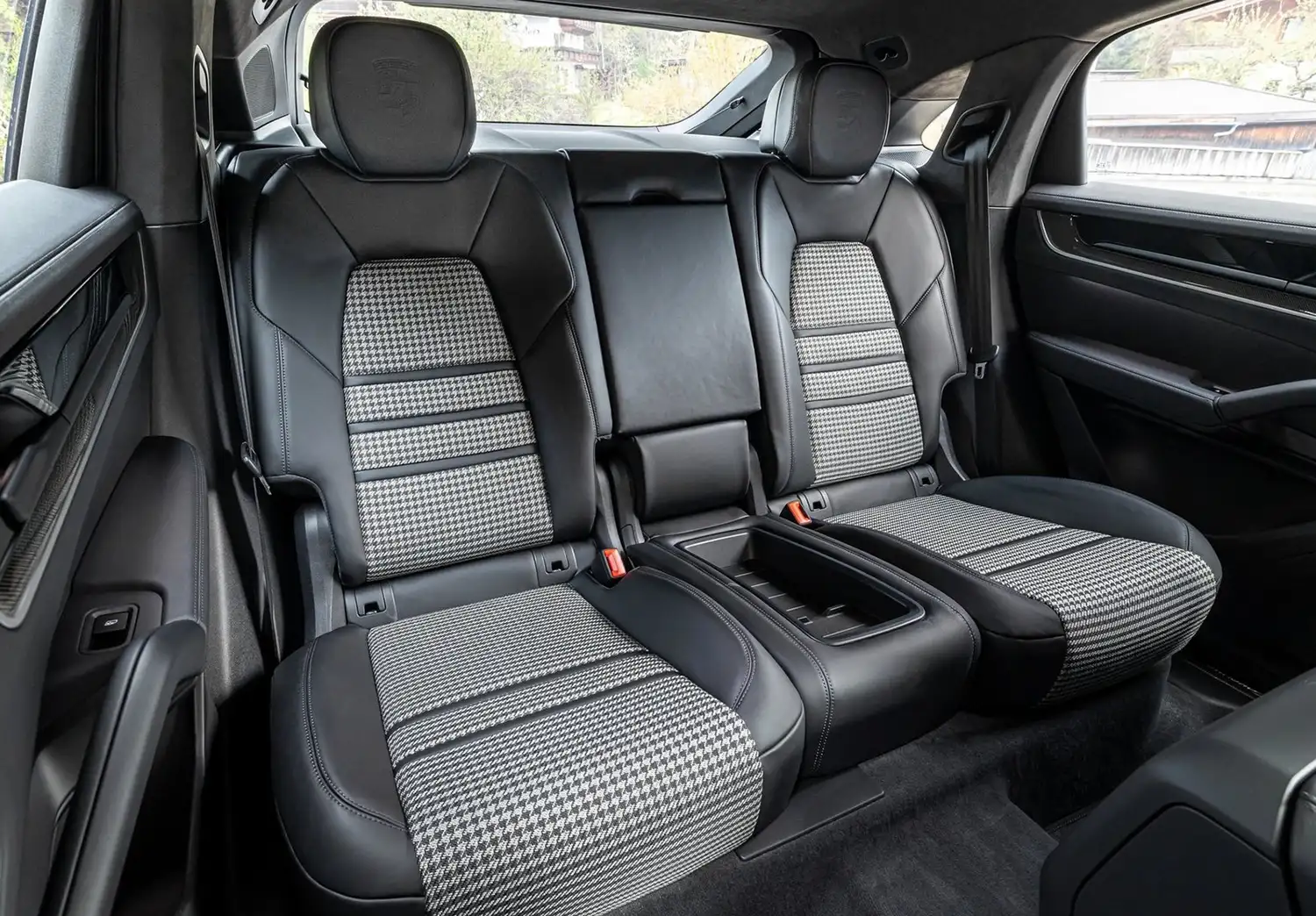
New and optimised assistance systems
The new Porsche Cayenne has a number of new and improved assistance systems. Its extended range of functions assists and relieves the driver on long drives, in traffic jams on motorways, when turning and in dangerous situations that require evasive manoeuvres.
The optional Adaptive Cruise Control comes with additional functions in the new Cayenne. One of them is the new Evasion Assist function. If the driver has to steer around a truck, car or motorbike in a critical situation, the assistant calculates the ideal evasion route. As soon as the driver steers during the evasive manoeuvre, Evasion Assist provides support with a situation-specific adjustment of the steering angle and targeted braking of individual wheels. This enables the vehicle to get to the calculated evasion route. The functional scope of the system also supports counter steering into the parallel lane, depending on the situation. In other words, the new Cayenne helps its driver avoid leaving the lane or crossing to the parallel lane.
Another function of Adaptive Cruise Control is the new Turn Assist capability. This function monitors oncoming traffic when turning left (or when turning right for right-hand drive countries) up to a maximum speed of 10 km/h. It also pre-conditions the braking system and thereby shortens the possible stopping distance. If there is a threat of a collision with oncoming traffic, Turn Assist automatically brakes the vehicle until it comes to a standstill. At the same time, it warns drivers both audibly and visually.
Porsche has also optimised the Lane Keeping function of the InnoDrive system, an extensive functional upgrade of Adaptive Cruise Control. The new Cayenne now keeps its lane even more reliably in congestion situations at up to 60 km/h with a vehicle driving ahead. If desired, the system can perform lane keeping in slow-moving and stop-and-go traffic on motorways and well-developed country roads, with continual steering interventions. It always prioritises lane markings, but also uses vehicles ahead for orientation. The new range of functions significantly increases driving comfort and demands less effort from the driver. Hands-off monitoring ensures that the driver is paying attention, as the driver remains responsible for the vehicle. If the driver takes their hands off the steering wheel, the system audibly and visually prompts them to resume control. If there is no reaction, the familiar Emergency Stop function automatically brings the vehicle to a standstill within the detected lane and then makes an emergency call.
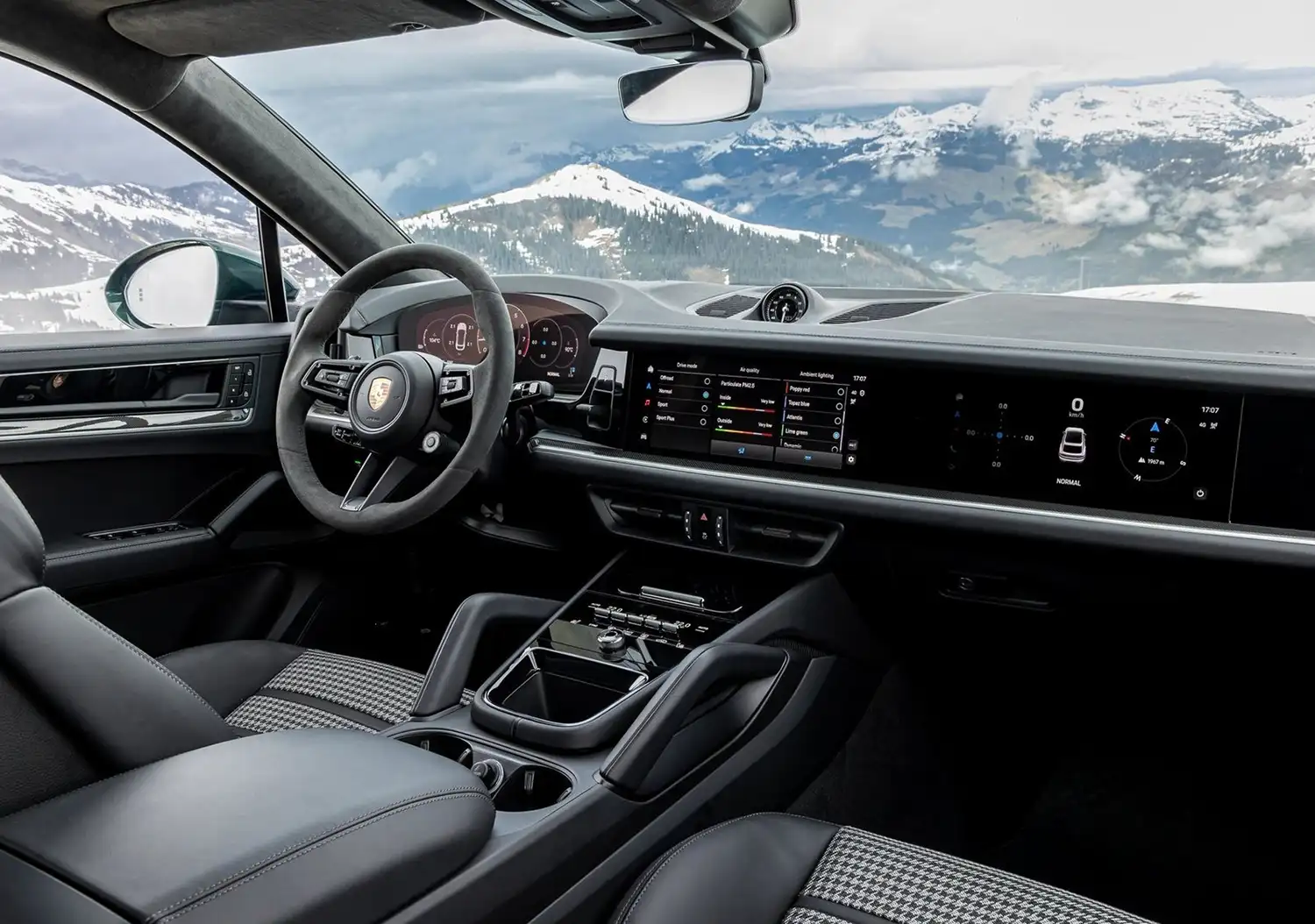
Greater comfort and sportiness at the same time
The new Cayenne is equipped with steel spring suspension as standard, including Porsche Active Suspension Management (PASM) for the first time. The regulated vibration dampers for the front and rear axle used by Porsche Active Suspension Management are equipped with a new two-valve technology. Instead of one valve for damping the body and wheel movements, the damper now features two valves that allow the rebound and compression stages to be changed separately. The advantage of the new technology is a significant increase in comfort and in driving safety, thereby achieving an even broader range between the Comfort and Sport Plus suspension characteristics.
Compression and rebound when driving make different demands of the dampers positioned between the wheel and body. This means that any movements by the body must remain as smooth and comfortable for the passengers as possible. The wheel, which in contrast is considerably lighter in weight, still needs to exhibit good damping characteristics in even the worst road conditions to guarantee traction. The new two-valve technology goes a long way to resolving the conflict between the goals of comfort for the passengers and optimal wheel suspension without compromising driving safety. Depending on the situation, the valve for the compression stage can set variable damping forces independently of the valve for the rebound stage, and vice versa. This enables the new Cayenne to offer a clearly noticeable increase in comfort with a smoother vehicle body, better handling performance and improved support for rolling and pitching movements as standard.
Optional new adaptive air suspension further enhances the driving experience. A variable spring rate outperforms the steel set-up and the previous air suspension system in combination with the new two-valve technology. The variable spring rate is implemented by means of two air chambers that can be connected or disconnected by a valve. When driving slowly and overcoming obstacles, it impresses with a particularly comfortable spring and damper characteristic and enables the new Cayenne to effectively glide over the road surface. At the same time, the more dynamic spring rate of the air suspension and the new two-valve technology significantly improves driving performance and precision while noticeably reducing body movements.
Compared to the previous model, the developers of the new two-chamber air suspension have also increased the spread of the spring rates. This allows both the firmly tuned spring rate of the Turbo GT and the most comfortable spring rate of the previous model to be implemented in every new Cayenne with air suspension.
In the new Cayenne, the PASM is linked to the Sport Response Button on the steering wheel for the first time. Just as before, it prepares the engine and transmission for maximum responsiveness. In addition, it puts the suspension in Sport mode to get it ready for a dynamic driving situation. The function is available for 20 seconds in each case.
Wheels with a larger rolling circumference
With the use of new tyres with a larger diameter class of what is now 790 mm, Porsche has optimised rolling and edge characteristics. The increased wheel circumference allows a lower air pressure and therefore greater comfort. Thanks to their higher load capacity, the new tyres react more confidently to road damage. They also offer better performance on wet and dry surfaces as well as improved traction for all wheel sizes. The Cayenne achieves optimal driving values with the special performance tyres newly developed for the model. Their improved temperature resistance noticeably expands the vehicle’s limits compared to the previous Cayenne. In addition, there are also now 22-inch winter and all-weather tyres available, developed specifically for the Cayenne.
Fundamentally upgraded suspension systems
For the revised model, Porsche engineers reworked the Cayenne’s suspension systems and adapted them to the characteristics of the new tyres. A new configuration of the regulated differential lock of the Porsche Torque Vectoring Plus (PTV Plus) system significantly reduces the number of agile braking interventions. Nevertheless, the vehicle’s yaw response remains at the usual high level. This improves performance while maintaining agility. At low speeds, the steering interventions by the optional rear-axle steering are also more frequent and intensive. This leads to a more agile steering response when driving at low speeds.
The Cayenne E-Hybrid and the Cayenne S are equipped with a newly developed electric brake booster. The new hybrid model allows a smoother transition between the friction brakes and deceleration by means of energy recuperation. This leads to a consistent, natural pedal feel and ensures optimal delivery of braking power. The optimised brake control system takes the tyre temperature into account and adjusts the anti-lock brake system (ABS) accordingly, among other factors. This increases the efficiency of the braking process, especially in demanding situations, and improves the energy recovery (recuperation) from the braking process in the Hybrid model. The Cayenne S also features new brake discs with a larger diameter. They measure 410 mm at the front and 358 mm at the rear – an increase of 20 and 28 mm respectively compared to the previous car. These optimisations significantly boost the performance of the brakes in many situations and decrease braking distance in the process. The new Cayenne once again sets the standard as the sports car among SUVs.
Three optional Lightweight Sports Packages are available exclusively for the Cayenne Coupé. They reduce the weight of the vehicle by up to 33 kg and in doing so noticeably enhance driving dynamics. In addition to individual visual details and functional extras, all Lightweight Sports Packages include the carbon roof, eight-way sports seats and the 22-inch GT design wheels.
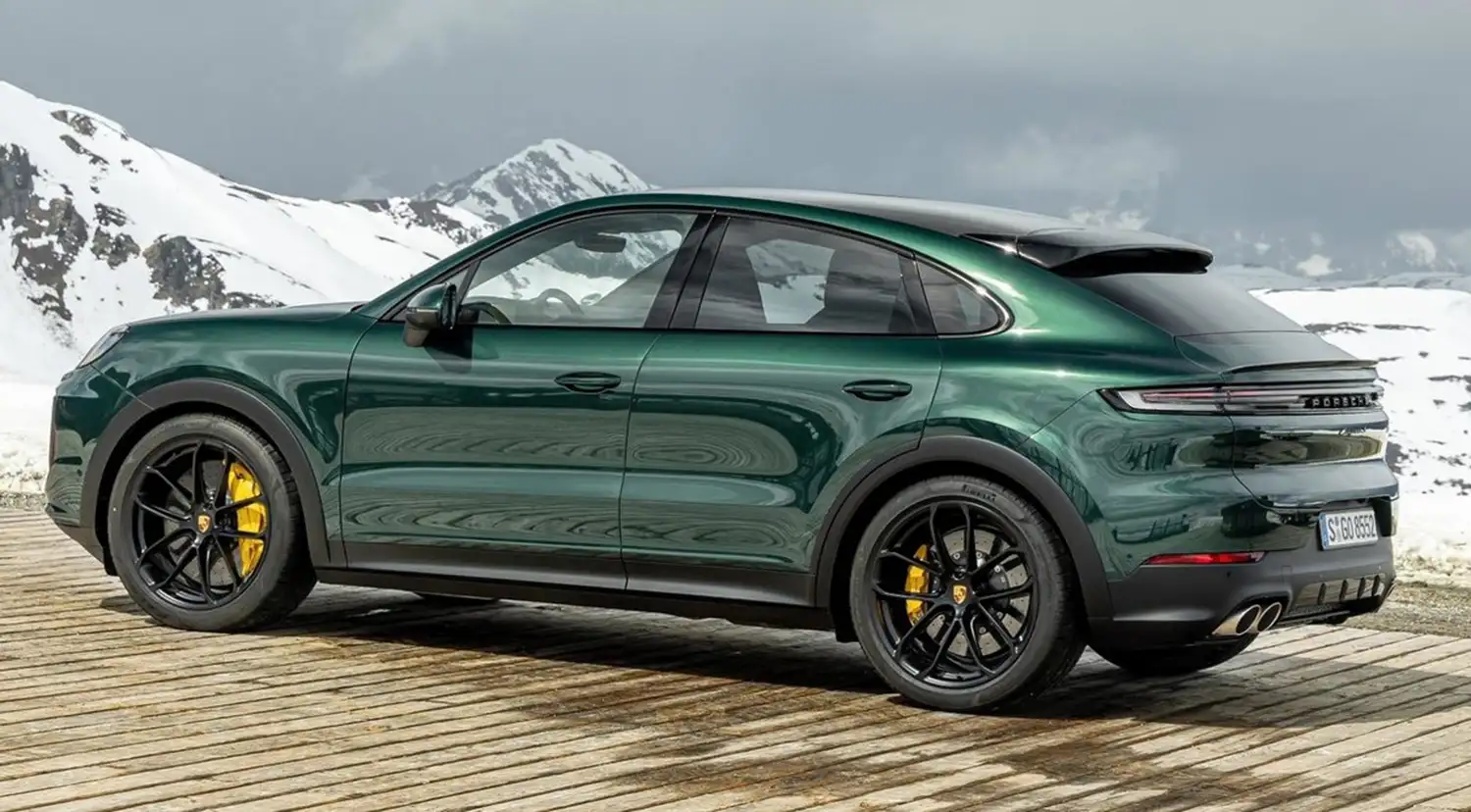
More power for even greater performance
Porsche has equipped the new Cayenne with extensively optimised engines. The Cayenne, Cayenne S and Cayenne E-Hybrid are significantly more powerful than their predecessors. The V6 engine in the Cayenne, for example, now generates 260 kW (353 PS) and 500 Nm of torque with the same 3.0-litre displacement. This is equivalent to an increase of 10 kW (13 PS) and 50 Nm. In conjunction with the optional Sport Chrono package, this shortens the sprint from zero to 100 km/h to a spritely 5.7 seconds. The Cayenne now reaches a top speed of 248 km/h. Its 3.0-litre V6 turbo also provides the combustion-engine base for the Cayenne E-Hybrid.
All variants of the new Cayenne are equipped with a revamped eight-speed Tiptronic S. With shorter reaction and shift times in Sport and Sport Plus modes, the automatic gearbox offers a noticeably improved performance. In Normal mode, the gearbox optimises the efficiency of the drive system. The Tiptronic S quickly shifts to the next higher gear to save fuel. Software optimisation also improves the interaction between the gearbox and the engine.
Cayenne S with 4.0-litre V8 biturbo engine
The new Cayenne S now comes with a bigger displacement: Porsche has replaced the previous 2.9-litre V6 with a new 4.0-litre V8 biturbo engine – achieving a significant power boost in the process: 349 kW (474 PS) and 600 Nm of torque amount to an increase of 25 kW (34 PS) and 50 Nm. The Cayenne S now accelerates to 100 km/h in 4.7 seconds and boasts a top speed of 273 km/h – accompanied by powerful and evocative sound characteristics typical of this engine layout.
For use in the new Cayenne S, the eight-cylinder has undergone an extensive overhaul: engineers focused on reducing consumption and emissions. Among other measures, this was achieved through the switch from a twin-scroll to a single-scroll turbocharger. The resulting higher exhaust-gas temperatures reduce fuel consumption in the highly dynamic range. In addition, a higher fuel injection pressure of 350 bar improves engine efficiency. New electrically controlled wastegates noticeably optimise the engine’s responsiveness. Porsche is also introducing a new two-stage variable valve lift in the Cayenne S for the first time. The intake camshafts now have two cam profiles per valve. Actuators switch between these profiles at lightning speed. At low engine loads, the engine operates with short valve opening times and minimal valve lift. At high loads, on the other hand, the system activates profiles with a large lift and long opening times in order to achieve a greater cylinder charge. In combination with the fully variable camshaft control (Vario Cam Plus), both states can be combined with short or long valve overlaps. New magnetoresistive camshaft sensors tap the full potential of this technology by determining the high-resolution position of the camshafts in real time. The engine control system precisely selects the appropriate valve timing for each load condition. This results in a noticeably improved performance while at the same time optimising CO2 values.
To ensure this performance on a reliable and continuous basis, Porsche also equips the first piston ring with a steel ring carrier. In combination with optimised piston cooling, this lends the eight-cylinder added robustness.
Plug-in hybrid optimised in three ways
In the new Cayenne, Porsche is expanding its electric drive portfolio to a total of three E-Hybrid models. The first is the new Cayenne E-Hybrid. It surpasses its predecessor in three respects: electric range, electric motor power and charging speed. Its sustainable hybrid strategy also optimises charging and discharge phases in different driving modes for the respective environment in which it finds itself. The result is a compelling driving experience with even greater efficiency.
The part of the conventional drive system in the new Cayenne E-Hybrid is handled by the 3.0-litre V6 turbo engine with 224 kW (304 PS). Porsche pairs it with a new electric motor, which is integrated into the eight-speed automatic transmission as before. A coil with an optimised number of turns as well as a new magnet and an increased phase current of the pulse inverter boost the electric power by 30 kW to 130 kW (176 PS) and the torque by 60 Nm to 460 Nm. Together, the combustion engine and electric motor achieve a combined output of 346 kW (470 PS). The system torque is 650 Nm. With the new drive system, the sprint to 100 km/h takes a mere 4.9 seconds. The top speed is 254 km/h.
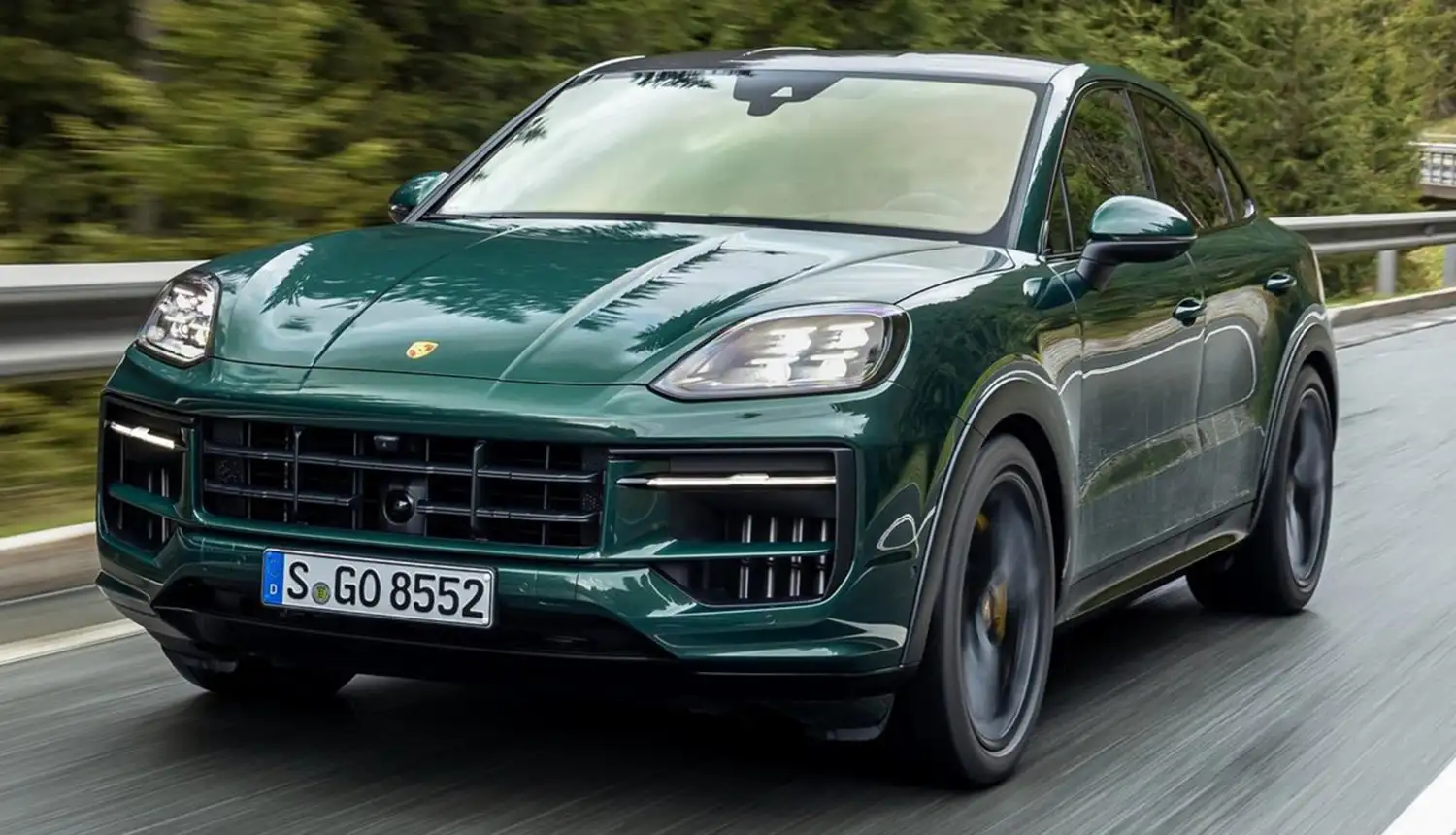
The new electric motor also improves the Cayenne E-Hybrid’s recuperation performance by around 30 per cent. In generator mode, the Cayenne can convert a power of up to 88 kW into electrical energy and supply it to the traction battery. This is how the new Cayenne E-Hybrid uses a significantly larger share of braking energy to increase efficiency and performance. Moreover, recuperation now decelerates the vehicle down to a speed of 2 km/h. In the previous model, it only braked the vehicle down to a speed of 14 km/h.
Beyond its increased drive and recuperation performance, as well as the resulting improved performance and efficiency, the new Cayenne E-Hybrid offers a higher electric range. A new high-voltage battery with a gross capacity of 25.9 kWh is installed beneath the load compartment floor as before. The 8 kWh of extra capacity enables a purely electric range of up to 90 km (EAER City) with a single battery charge.
To avoid longer charging times due to the larger capacity, the Cayenne E-Hybrid also has a new on-board AC charger as standard. With a charging capacity of 11 kW (against 7.2 kW previously), the HV battery can be fully charged at an appropriate power source in about two hours and 15 minutes.
E-Hybrid driving modes for maximum efficiency
Porsche has optimised the configuration of the driving modes in the new Cayenne E-Hybrid. In the performance-oriented Sport driving programme, the vehicle now maintains a minimum battery charge level of 20 per cent. In the predecessor, it was 30 per cent. In Sport Plus driving mode, the minimum charge level drops from 80 to 30 per cent. The new strategy reduces the number of charging phases in which the motor feeds the battery. This improves the overall efficiency of the vehicle without affecting performance.
E-Charge mode for dynamic charging of the vehicle now also works more efficiently. When the new Cayenne is driving in built-up areas and at speeds of less than 55 km/h, the drive system operates in hybrid mode – the combustion engine and the electric motor share the workload. In this situation, the vehicle maintains a constant charge level. Out of town, the internal combustion engine takes over completely while simultaneously building up the electric range. It is able to charge the battery to a maximum charge level of 80 per cent. This enables the vehicle to generate electric range for later local emission-free trips with maximum efficiency. Hybrid-Auto mode benefits from the inclusion of environmental data in the drive system strategy by enabling a higher proportion of the route to be driven purely electrically in urban areas. This value gets even better with active route guidance.
